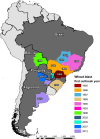Wheat Blast: A Disease Spreading by Intercontinental Jumps and Its Management Strategies
- PMID: 34367228
- PMCID: PMC8343232
- DOI: 10.3389/fpls.2021.710707
Wheat Blast: A Disease Spreading by Intercontinental Jumps and Its Management Strategies
Abstract
Wheat blast (WB) caused by Magnaporthe oryzae pathotype Triticum (MoT) is an important fungal disease in tropical and subtropical wheat production regions. The disease was initially identified in Brazil in 1985, and it subsequently spread to some major wheat-producing areas of the country as well as several South American countries such as Bolivia, Paraguay, and Argentina. In recent years, WB has been introduced to Bangladesh and Zambia via international wheat trade, threatening wheat production in South Asia and Southern Africa with the possible further spreading in these two continents. Resistance source is mostly limited to 2NS carriers, which are being eroded by newly emerged MoT isolates, demonstrating an urgent need for identification and utilization of non-2NS resistance sources. Fungicides are also being heavily relied on to manage WB that resulted in increasing fungal resistance, which should be addressed by utilization of new fungicides or rotating different fungicides. Additionally, quarantine measures, cultural practices, non-fungicidal chemical treatment, disease forecasting, biocontrol etc., are also effective components of integrated WB management, which could be used in combination with varietal resistance and fungicides to obtain reasonable management of this disease.
Keywords: Intercontinental spread; Magnaporthe oryzae pathotype Triticum; disease spread; integrated disease management; wheat blast.
Copyright © 2021 Singh, Gahtyari, Roy, Roy, He, Tembo, Xu, Juliana, Sonder, Kabir and Chawade.
Conflict of interest statement
The authors declare that the research was conducted in the absence of any commercial or financial relationships that could be construed as a potential conflict of interest.
Figures







References
-
- Alves K. J. P., Fernandes J. M. C. (2006). Influência da temperatura e da umidade relativa do ar na esporulação de Magnaporthe grisea em trigo. Fitopatol. Bras. 31 579–584. 10.1590/S0100-41582006000600007 - DOI
-
- Anh V. L., Anh N. T., Tagle A. G., Vy T. T. P., Inoue Y., Takumi S., et al. (2015). Rmg8, a new gene for resistance to Triticum isolates of Pyricularia oryzae in hexaploid wheat. Phytopathology 105 1568–1572. - PubMed
-
- Aucique-Pérez C. E., Resende R. S., Cruz N. L. B., Dornelas F., DaMatta F. M., Rodrigues F. Á. (2019). Picolinic acid spray stimulates the antioxidative metabolism and minimizes impairments on photosynthesis on wheat leaves infected by Pyricularia oryzae. Physiol. Plant. 167 628–644. 10.1111/ppl.12917 - DOI - PubMed
-
- Bado S. (2015). Advances in Plant Mutation Breeding. Ph.D. Thesis. Vienna: University of Natural Resources and Life Sciences.
Publication types
LinkOut - more resources
Full Text Sources
Research Materials

